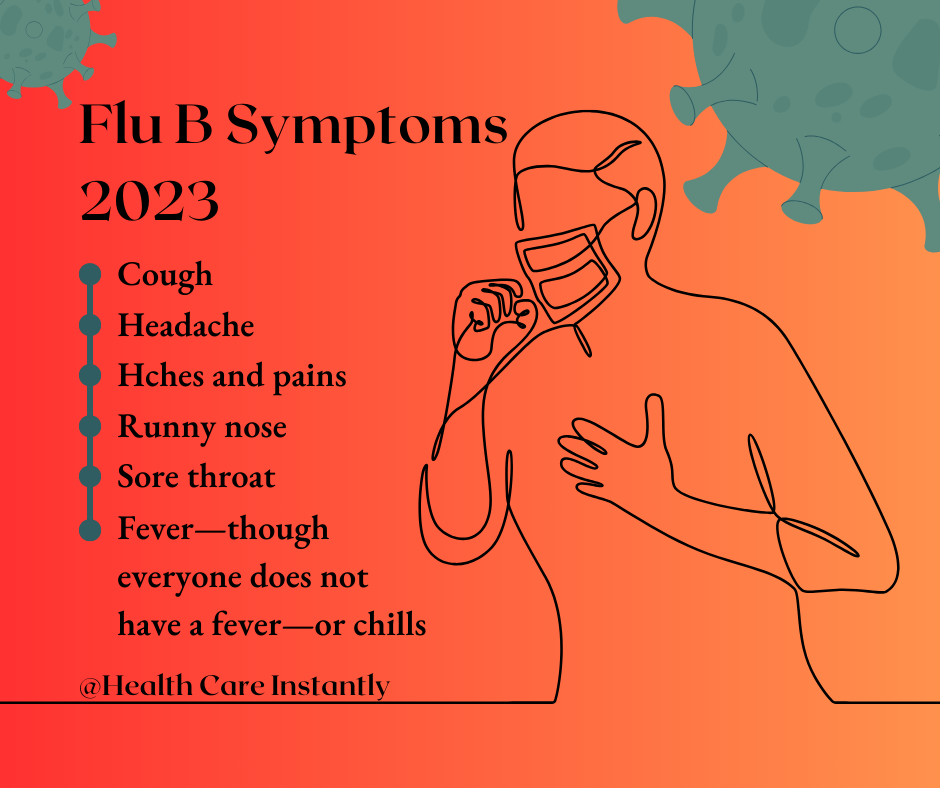"flu b symptoms 2023" : What You Should Know About The Influenza Virus
What distinguishes influenza A from influenza B, and which is more serious?

Knowing the differences between influenza Type A and Type B becomes important during the yearly dance with the flu. With their distinct traits, these viral foes contribute significantly to the rise and fall of illness during flu season. Let’s examine Type B influenza symptoms in 2023, distinguishing between Type A and Type B influenza, and examining the subtleties that are important.
Flu B Symptoms 2023
Influenza A vs. Influenza B: The Combating Forces
The influenza battlefield opens its doors in the fall, with Type A and Type B viruses occupying the main roles. More than seventy-five percent of cases are caused by influenza A, the early riser. However, Influenza B adds a distinct twist to the flu story with its smaller but still noticeable peak in late February or early March.
According to Anice Lowen, an associate professor of microbiology and immunology at Emory University School of Medicine, the flu landscape is determined by the relative abundance of one virus over another at any given time. It’s important to investigate the distinctions between these two influenza types in order to understand the subtleties.
Analyzing Influenza A and B: What Makes Them Different?
Influenza A has many different subtypes, but the most well-known is H1N1. Interestingly, a large number of influenza A viruses have been found in animals, which could be a source of pandemics if these viruses spread to people. Type A viruses caused historical pandemics in 1918, 1957, 1968, and the 2009 swine flu outbreak.
On the other hand, influenza B viruses are only found in humans and are classified into two lineages that cause seasonal outbreaks. Flu seasons are shorter and more predictable due to influenza B’s slower evolution than influenza A. Professionals from all over the world keep a close eye on flu trends and work hard to forecast changes in the virus that could affect how effective yearly flu shots are.
Discovering the Signs of an Influenza Ailment
Understanding the symptoms of the flu becomes critical in case it strikes. The classic symptoms are chills, fever that comes on suddenly, sore throats and coughs, chills, and muscle aches along with exhaustion. For otherwise healthy people, the flu usually lasts three to seven days, during which time it can cause fatigue and a chronic cough.
A comparison of hospitalization and mortality rates for Type A and Type B infections in adults shows that, contrary to previous beliefs, Type A infections are not more serious. Influenza B, however, has the potential to cause more severe illness and increased death rates in children.

Complications and Repercussions: Recognizing the Hazards
Pneumonia, a potentially dangerous lung infection brought on by the flu virus or secondary bacterial infections, is the most frequent side effect of severe influenza. Furthermore, a strong inflammatory response brought on by the flu can exacerbate chronic pre-existing conditions like asthma or heart disease.
Finding the Intruder: Differentiating Between Influenza A and Influenza B
Rapid tests that can differentiate between influenza A and B are available in medical facilities in the quest to pinpoint the precise influenza type causing infection. More sensitive P.C.R. tests can offer comprehensive insights into the flu virus causing the symptoms, even though these tests might not be as sensitive.
Managing the Flu Terrain with Treatment Approaches
Relieving symptoms and bolstering the body’s defenses are the main goals of treating flu, regardless of the strain. To reduce the length and intensity of illness, four antiviral drugs have been approved, including Tamiflu. But these are usually only given to people who are really at risk of serious side effects, like those who are 65 years of age or older, pregnant women, and people with long-term medical conditions.
Taking over-the-counter fever-reducing medications, getting plenty of rest, and drinking plenty of water are advised for people recuperating at home. Stronger influenza medication may be required if symptoms worsen and include breathing difficulties, acute chest or stomach pain, or a persistent fever of 102 degrees or higher.
It’s critical to comprehend the subtleties of Flu B symptoms in 2023 if one is to relentlessly strive to outrank the information landscape. With this comprehensive guide, you will be well-equipped to manage flu season by understanding the differences between Influenza A and B, recognizing symptoms, and avoiding complications.

- Cough.
- Fatigue.
- Fever—though everyone does not have a fever—or chills.
- Gastrointestinal symptoms like vomiting and diarrhea—which are more common in children.
- Headaches.
- Muscle or body aches.
- Runny nose.
- Sore throat.
TAKE CARE ALL THE TIME : @Theusaexpress.com/News/Majaharul Islam

✍️ Majaharul Islam is the Owner of The Usa Express news .He’s published an International news .
✍️The brains behind “theusaespress.com,” Majaharul Islam, are dedicated to sharing the newest information. Our mission is to provide our audience with a wide range of current and relevant news on a regular basis so they are always well-informed. To experience news in its entirety, go to “theusaespress.com”.



